
Nintendo has been the most enduring and influential company in the gaming medium and its consoles. Branding and innovative game achievements have given the company a momentous status in popular culture. And so 30 years after the NES hit North American shores, we’ve decided to compile a list of the 100 greatest Nintendo games. Here is part two.
 90. Kid Icarus
90. Kid IcarusDeveloper(s) Nintendo R&D1
Publisher(s) Nintendo
Director(s) Satoru Okada
Platform(s) Nintendo Entertainment System
NA July 1987
Genre(s) Action, platforming
–
The game was directed by Satoru Okada and produced by the general manager of the R&D1 division, the same team who developed Metroid a year earlier. Both games ran on the same engine, shared similar level designs and even a few notorious enemies, and so one of the most striking aspects of Kid Icarus is how similar it feels to its sister game. Yet Pit has always been overshadowed by Samus Aran, making Kid Icarus something of a black sheep among all of the NES classics. While this game has a devout legion of followers, there are just as many people who dislike it. After it’s debut in 1986 and a lone sequel for the Gameboy, Nintendo made the decision to clip Pit’s wings and the game series lay dormant for 21 years – a baffling choice considering Pit is one of Nintendo’s most iconic protagonists. Every system out there has at least one wildly underrated game, and on the NES it’s Kid Icarus. It may not be on the same level as its first party NES peers but it shares a lot in common with Nintendo’s ‘Big Three’ – and thanks to Super Smash, the Nintendo icon finally got his dues. (Ricky D)
–
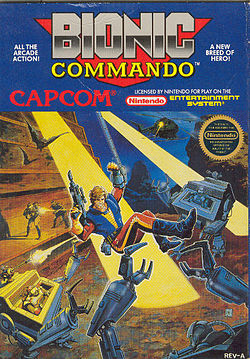 89. Bionic Commando
89. Bionic CommandoDeveloper(s) Capcom
Publisher(s) Capcom
Designer(s) Hatchan
Platform(s) Famicom/NES
NA December 1988Genre(s) Action, Platforming
–
Loosely based on an arcade game of the same name, Bionic Commando is another Capcom classic that every self-respecting old-school gamer has fond memories of playing. A side-scroller with an interesting slant, Bionic Commando is best known as the unique platformer which actually removes the feature of jumping, and forces you to instead use a grappling hook to swing and climb through every level. At first, the game’s emphasis on swinging seems counterintuitive and frustrating, but those who spend the time needed to really master its controls will feel ultimately rewarded. Taking cues from open-ended adventure games like Metroid, Bionic Commando is more about exploration and combat than running from one side of the screen to the next. There’s an assortment of weapons and equipment your main character picks up along the way and sometimes you’ll find yourself returning to a stage to complete your mission. In the Famicon incarnation, a group of modern day Nazis attempt to resurrect Adolph Hitler and take over the world. But in the US release, all references to Nazism in text and imagery were removed and the Imperial Army’s Swastika insignia was changed into a new one resembling an eagle. Of all the games I own on the NES, Bionic Commando is by far my favorite, and one of the toughest to finish. (Ricky D)
–
–
Loosely based on an arcade game of the same name, Bionic Commando is another Capcom classic that every self-respecting old-school gamer has fond memories of playing. A side-scroller with an interesting slant, Bionic Commando is best known as the unique platformer which actually removes the feature of jumping, and forces you to instead use a grappling hook to swing and climb through every level. At first, the game’s emphasis on swinging seems counterintuitive and frustrating, but those who spend the time needed to really master its controls will feel ultimately rewarded. Taking cues from open-ended adventure games like Metroid, Bionic Commando is more about exploration and combat than running from one side of the screen to the next. There’s an assortment of weapons and equipment your main character picks up along the way and sometimes you’ll find yourself returning to a stage to complete your mission. In the Famicon incarnation, a group of modern day Nazis attempt to resurrect Adolph Hitler and take over the world. But in the US release, all references to Nazism in text and imagery were removed and the Imperial Army’s Swastika insignia was changed into a new one resembling an eagle. Of all the games I own on the NES, Bionic Commando is by far my favorite, and one of the toughest to finish. (Ricky D)
–

Developer(s) Intelligent Systems
Publisher(s) Nintendo
Platform(s) GameCube
NA October 11, 2004
Genre(s) Role-playing video game
–
The Paper Mario series is a strange beast. Born out of Super Mario RPG: The Legend of the Seven Stars on the SNES, developers Intelligent System decided to go with a completely flat, 2D art style for Super Mario RPG 2 on the N64. A quick name change later, and Paper Mario was born. With the second game in the series (or third, it’s all rather confusing), The Thousand Year Door on Gamecube, Intelligent Systems decided not to rock the boat too much. Visually, it’s very similar to its N64 predecessor – everything in this game both looks and acts just like their paper moniker would suggest. From enemies that crumple when bounced on, to backgrounds that can be peeled back to reveal hidden pathways. Even Mario himself has various paper-based power ups, such as being able to fold into a paper airplane or boat to aid in travel. And despite the 2D look and bright art style, The Thousand Year Door is an RPG at heart. Players level up, gain new skills and fight enemies in turn-based battle stages separate from the main game. Its plot is pretty standard RPG fare – travel to various lands and collect seven crystal stars to unlock the titular door, whilst helping out various locals with their side-quests and upgrading your weapons and equipment. The script, however, is no less that what you would expect from the makers of the Mario and Luigi games on handhelds – that is, hilarious. With continual laugh out loud moments, it certainly helps … paper … over the cracks in the rather routine plot (sorry). An unlikely combination, then, but for fans of Mario, RPGs and comedy, it’s not hard to recommend The Thousand Year Door. (Tariq Ashkanani)
–
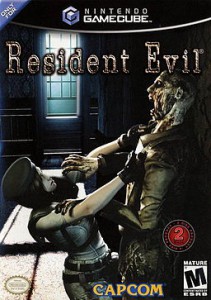 87. Resident Evil (Remake)
87. Resident Evil (Remake)Developer(s) Capcom Production / Studio 4
Publisher(s) Capcom
Platform(s) GameCube
March 22, 2002
Genre(s) Survival horror
–
The original Resident Evil was hands-down the most influential game ever produced in the survival-horror genre. Not only was it a frightful blast to play, it was also one of the scariest games anyone had ever seen at the time. Now, about those production values… You see, on the flip side it was also a hall of shame for Capcom, with terrible line-readings, a badly-acted live action sequence, and some ridiculous writing added in for good measure. So how did Capcom rectify this embarrassment to their newly minted flagship franchise? Well, with a remake of course. And what a remake! This vastly graphically-superior and much better designed redux of Resident Evil is the game that fans wanted and deserved. Integrating some of the best aspects of the sequels that followed the original title, Capcom created a whole new game from top to bottom. Then they went the extra mile and even added in entirely new content, such as the pants-crapping terror known as the “crimson-head” zombie. Aside from the title-holding champion Resident Evil 4 and the genre-redefining Resident Evil 2, the REmake is easily the standout game of the series, and if you’re a fan of horror gaming who hasn’t played it yet, than you’re depriving yourself of an ageless classic for the genre. (Mike Worby)
–
 86. Super Mario Sunshine
86. Super Mario SunshineDeveloper(s) Nintendo EAD
Publisher(s) Nintendo
Director(s) Yoshiaki Koizumi / Kenta Usui
Platform(s) Nintendo GameCube
NA August 26, 2002
Genre(s) Platforming
Mode(s) Single-player
–
For Mario’s first (and last) solo outing on the Gamecube, Nintendo were faced with a blinder of a conundrum: how the hell do we follow that??! Super Mario 64 hadn’t just been a brilliant platformer, but a genuine game-changing title, whose repercussions can still be seen to this day. The answer? Strap a water-pack to Mario’s back and let him loose in a vibrant world bursting with color. Super Mario Sunshine saw everyone’s favorite plumber charged with vandalism (seriously) and tasked with using FLUDD – a Ghostbusters-style water hose/James Bond jetpack – to wash it all away. The game that followed may not have been as good as the one that came before (or after, for that matter), but even an average Mario title is still better than most platformers out there. The FLUDD system allowed players to interact with the environment in new ways – soaking enemies, sucking up and firing fruit – as well as enhancing Mario’s basic movement: using jets of water to hover, for instance, certainly helped in the game’s many tricky platform sections. All things considered, Sunshine is easily one of the tougher Mario games out there, and collecting all 120 shine sprites was a true test at times – especially in the FLUDD-less obstacle levels. Often unfairly looked over, Super Mario Sunshine is a lot of fun and an excellent challenge. (Tariq Ashkanani)
–
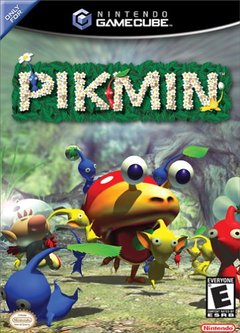 85. Pikmin
85. PikminDeveloper(s) Nintendo EAD
Publisher(s) Nintendo
NA December 2, 2001
Genre(s) Real-time strategy
–
One of the early titles for the Gamecube, Pikmin tells the story of Captain Olimar, whose spacecraft crash lands on their planet. Needing their help to retrieve the scattered parts of his ship, Olimar has 30 days to collect everything and blast off before his life support system fails. Talk about an incentive… Playing much like an RTS, players must direct crowds of pikmin through various geography-based puzzles. Red pikmin, for instance, are resistant to fire, whilst blue pikmin can march through water undisturbed. Guiding, splitting and reforming Olimar’s loyal followers is key to collecting every piece of his spacecraft. Whilst successful enough to spawn two sequels, Pikmin never really did the numbers it probably deserved. One of the last new IPs to come from legendary developer Shigeru Miyamoto (the final being Nintendogs), it’s a charming little game that’s perhaps rather overlooked – for fans of Miyamoto’s more whimsical and experimental games, Pikmin comes highly recommended. (Tariq Ashkanani)
–
–
–
–
 84. Phoenix Wright: Ace Attorney
84. Phoenix Wright: Ace AttorneyDeveloper(s) Capcom
Publisher(s) Capcom
Platform(s) Game Boy Advance
October 11, 2001
Genre(s) Adventure, visual novel
–
No other game is quite like Phoenix Wright: Ace Attorney. Featuring the stories of defense attorney Phoenix Wright, players must solve a variety of court cases. Each of these cases are separated into different game modes: investigation and trial mode. During the investigation, Phoenix much gather evidence and talk with the varied personalities of those involved with the crime. When the game transitions to the trial, Phoenix must use the evidence to his advantage, cross-examining witnesses and solving the mystery. What really has made Phoenix Wright so successful are the characters and catchphrases. Hearing Phoenix shout “Objection!” or “Hold it!” provides a thrilling rush to the proceedings. Add in some very intriguing characters such as Mia Fey, Miles Edgeworth, and Dick Gumshoe and you’ve got yourself a series that continues to captivate years later. (Max Covill)
–
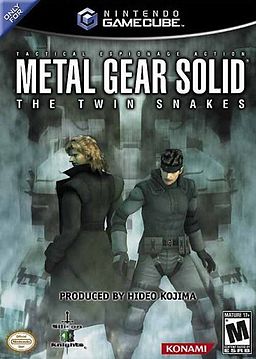 83. Metal Gear Solid: The Twin Snakes
83. Metal Gear Solid: The Twin SnakesDeveloper(s) Silicon Knights
Publisher(s) Konami
Platform(s) GameCube
NA March 9, 2004
JP March 11, 2004
Genre(s) Action-adventure, stealth
–
The 1998 PSX masterpiece, Metal Gear Solid, got a whole new makeover when Nintendo announced a remake on the Gamecube in 2003. It felt almost like a homecoming party considering the first Metal Gear series began with Nintendo. Developed by Silicon Knights under the guidance of Hideo Kojima (Metal Gear) and Shigeru Miyamoto (Super Mario Bros.), the game was rebuilt with the same engine used in Metal Gear Solid 2: Sons of liberty and with an improved AI to boot. This was an absolute treat for gamers who never got an opportunity to play the original classic, and for fans of the series to return to Shadow Moses and replay the game that started it all. Most of the narrative remains fully intact, but the voice work had to be re-recorded since the increased audio quality picked up sounds that were inaudible in the original PSX release. There’s not enough that can be said about how incredible this game was and still is today. Revisiting classic bosses such as Sniper Wolf, Vulcan Raven and my personal favorite Psycho Mantis–for nostalgia alone, this is a game which is well deserved of a spot on this list. (Aaron Santos) 82. Xenoblade Chronicles
82. Xenoblade Chronicles
Developer(s) Monolith Soft / Nintendo SPD
Publisher(s) Nintendo
Platform(s) Wii, New Nintendo 3DS
NA 6 April 2012[5]
Genre(s) Action role-playing
–
As the poster child for the grassroots campaign called Project Rainfall, this is the game that reminded the Japanese gaming industry just what RPG fans were looking for in the new console cycle.The first thing that you really notice when you pick up a copy of Xenoblade Chronicles is just what a massive game it really is. Brimming with one giant map after another to explore, and an insane list of over 500 side-quests, Xenoblade is not a game for the faint of heart (or those who lead particularly busy lives for that matter). As the latest in the highly varied Xeno series, Xenoblade Chronicles is the most polished and addictive title that Monolith Soft has produced to date. By incorporating MMO ideals into what is otherwise a standard JRPG, Monolith has created one of the great RPGs of this generation in what amounts to an endlessly playable time-sink that makes a Final Fantasy game look like a quick jaunt by comparison. While it may lack the originality of Xenogears or the mature story-telling chops of Xenosaga, what Xenoblade does bring to the table is a game that you can play for over 200 hours without ever getting bored of it. (Mike Worby)
 81. Pokemon Black/White
81. Pokemon Black/White
Platform(s) GameCube
NA March 9, 2004
JP March 11, 2004
Genre(s) Action-adventure, stealth
–
The 1998 PSX masterpiece, Metal Gear Solid, got a whole new makeover when Nintendo announced a remake on the Gamecube in 2003. It felt almost like a homecoming party considering the first Metal Gear series began with Nintendo. Developed by Silicon Knights under the guidance of Hideo Kojima (Metal Gear) and Shigeru Miyamoto (Super Mario Bros.), the game was rebuilt with the same engine used in Metal Gear Solid 2: Sons of liberty and with an improved AI to boot. This was an absolute treat for gamers who never got an opportunity to play the original classic, and for fans of the series to return to Shadow Moses and replay the game that started it all. Most of the narrative remains fully intact, but the voice work had to be re-recorded since the increased audio quality picked up sounds that were inaudible in the original PSX release. There’s not enough that can be said about how incredible this game was and still is today. Revisiting classic bosses such as Sniper Wolf, Vulcan Raven and my personal favorite Psycho Mantis–for nostalgia alone, this is a game which is well deserved of a spot on this list. (Aaron Santos)
–

Developer(s) Monolith Soft / Nintendo SPD
Publisher(s) Nintendo
Platform(s) Wii, New Nintendo 3DS
NA 6 April 2012[5]
Genre(s) Action role-playing
–
As the poster child for the grassroots campaign called Project Rainfall, this is the game that reminded the Japanese gaming industry just what RPG fans were looking for in the new console cycle.The first thing that you really notice when you pick up a copy of Xenoblade Chronicles is just what a massive game it really is. Brimming with one giant map after another to explore, and an insane list of over 500 side-quests, Xenoblade is not a game for the faint of heart (or those who lead particularly busy lives for that matter). As the latest in the highly varied Xeno series, Xenoblade Chronicles is the most polished and addictive title that Monolith Soft has produced to date. By incorporating MMO ideals into what is otherwise a standard JRPG, Monolith has created one of the great RPGs of this generation in what amounts to an endlessly playable time-sink that makes a Final Fantasy game look like a quick jaunt by comparison. While it may lack the originality of Xenogears or the mature story-telling chops of Xenosaga, what Xenoblade does bring to the table is a game that you can play for over 200 hours without ever getting bored of it. (Mike Worby)
–
 81. Pokemon Black/White
81. Pokemon Black/WhiteDeveloper(s) Game Freak
Publisher(s) Nintendo,
Platform(s) Nintendo DS
NA March 6, 2011[3][4]
Genre(s) Role-playing
–
Coming into the fifth generation of the popular series of handheld Pokémon games, Nintendo and game director Junichi Masuda had to bring something different to the table. So in 2010, Masuda announced that with the new additions to the franchise, Black and White, he reviewed the divisive features of the previous generations and effectively started from scratch with 156 new Pokemon, with the intention of levelling the playing ground between veteran and new players alike. In a practical reset for a new generation of Pokémon masters, Black and White puts a spin on multi-character battle styles, established type advantages and disadvantages, and the concept of a 3D city showcases the land of Unova in a refreshingly modern style. The revamped gameplay is a breath of fresh air for established players whereas the appeal of collecting, fighting and exploring wins the hearts of newer fans, introducing them to a franchise that is almost 30 years old. (Katie Wong)
–
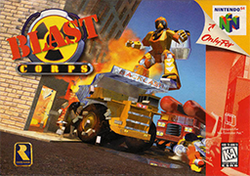 Special Mention: Blast Corps
Special Mention: Blast CorpsDeveloper(s) Rare
Publisher(s) Nintendo
Platform(s) Nintendo 64
NA February 28, 1997
Genre(s) Action, puzzle
–
Blast Corps is a brilliant concept for a puzzle game featuring a very simple objective: destroy a series of buildings using a variety of unique demolition vehicles, mainly in order to clear a path for a truck carrying a pair of defective nuclear missiles. It may sound simple, and in the early stages it is, but as the game progresses, it can be a bit difficult to control and unlike traditional puzzle games, you have only mere seconds to react before it all goes wrong. While the graphics are a bit dated, it remains a blast to play and makes for an awesomely re-playable experience. Blast Corps was a breath of fresh air across the seemingly never-ending sequels released on the N64 and an evolution of the destroy-’em-up-genre, taking everything we love about games like Rampage and ushering it into the 64 era. (Ricky D)
–
Blast Corps is a brilliant concept for a puzzle game featuring a very simple objective: destroy a series of buildings using a variety of unique demolition vehicles, mainly in order to clear a path for a truck carrying a pair of defective nuclear missiles. It may sound simple, and in the early stages it is, but as the game progresses, it can be a bit difficult to control and unlike traditional puzzle games, you have only mere seconds to react before it all goes wrong. While the graphics are a bit dated, it remains a blast to play and makes for an awesomely re-playable experience. Blast Corps was a breath of fresh air across the seemingly never-ending sequels released on the N64 and an evolution of the destroy-’em-up-genre, taking everything we love about games like Rampage and ushering it into the 64 era. (Ricky D)
–
–

